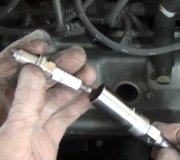Check this TSB 1st
MIL ILLUMINATED - SYSTEM LEAN DTC'S - POSSIBLE VACUUM LEAKS - SERVICE TIP
TECHNICAL SERVICE BULLETIN
Reference Number(s): 01-038/04
MAZDA:2000-2004 B Series; 2001-2004 Tribute
SECTION:Engine
Related Ref Number(s): 01-038/04
ARTICLE BEGINNING
APPLICABLE MODEL(S)/VINS
2000-2004 B-Series
2001-2004 Tribute
DESCRIPTION
Some vehicles may set DTC's P0171and, or P0174, P1130, P1131, P1150, P1151, P2195, or P2197 (system lean or lack of HEGO switches). This article is intended to aid in diagnosing these DTC's when a vacuum leak is present and to prevent unnecessary replacement of HEGO sensors, MAF sensors, and/or PCM's.
Perform the following inspections/repairs when the above DTC's are found in memory. This procedure provides instructions on how to make comparisons of the total fuel corrections (using scan tool or equivalent) at idle and high RPM's to help determine if a vacuum leak is the root cause of the DTC's.
REPAIR PROCEDURE
NOTE:Freeze frame and adaptive fuel values (associated with "LONGFT" PID) will not be available if a KAM or OBD II reset was recently performed.
NOTE:Freeze frame data will indicate the engine and ambient conditions when the DTC was set. These are important because the vacuum leak may only occur within specific temperature ranges and must be duplicated to detect the leak.
NOTE:Fuel trims at idle are particularly sensitive to vacuum leaks since the un-metered air "leakage flow" is a higher percentage of total airflow at idle than at part throttle. The barometric pressure (BP) PID is not recommended to view when diagnosing a vacuum leak. BP is an inferred PID calculated during higher engine loads.
Verify customer concern.
Perform preliminary inspection of fuel, induction and EGR systems. Retrieve and record DTC's and Freeze Frame Data.
NOTE:Do not perform KAM reset or OBDII reset (clear codes) at this time, adaptive fuel tables must be intact for this procedure.
If DTCs are continuous, or if other DTC's or drive symptoms are present other than at idle, first diagnose and repair those DTCs/symptoms.
Perform visual inspection - look for disconnected/broken/cracked vacuum hoses especially near vacuum trees. Check PCV elbows for cracks or loose connection. Confirm vehicle has the correct PCV valve installed. If a suspect vacuum leak is found proceed to STEP 5.
NOTE:Each vehicle application requires a PCV valve calibrated for that vehicle, however there will be a normal variation in fuel trims from vehicle to vehicle.
Determine if vacuum leak is present by analyzing total fuel correction at idle.
Set up scan tool to monitor the following PIDS: ECT/CHT, LONGFT1, LONGFT2, SHRTFT1, SHRTFT2, IAT.
Start the engine and run at idle with all accessories off-gear lever in Neutral/Park.
Run engine until ECT/CHT PID matches the corresponding FFD from STEP 2. This will duplicate the customer's engine operating temperatures when the DTC was set in memory. Hood may remain open during this test to help reduce ECT/CHT/IAT temperatures. Keep IAT below 115°F (46° C).
Record LONGFT's and SHRTFT's.
NOTE:To prevent high ECT/CHT and IAT temperatures it may be necessary to perform this test with the engine running for short intervals, especially when ambient temperature is above 85° F (29°C). Use of a garage fan will help to keep engine temperatures stabilized during test. It may be necessary to run this test at specific ECT/CHT/IAT temperatures, review freeze frame data.
EXAMPLE: If ECT was at 160° F (71° C) then engine may need a cold start to duplicate this temperature.
Determine total fuel correction at idle for an in-line 4 cylinder engine or bank 1 of a V-engine by adding LONGFT1 to SHRTFT1. Determine total fuel correction for bank 2 of a V-engine, by adding total fuel correction for bank 2 of a V-engine, by adding LONGFT2 to SHRTFT2.
NOTE:Make sure only the correct banks and trims are added together (do not add LONGFT1 to LONGFT2 or LONGFT1 to SHRTFT2). A typical vacuum leak which may set a lean code DTC will have total correction of around +20% or greater at or near idle (depends on calibration).
EXAMPLE 1: BANK1 long fuel trim; LONGFT1 = +13% and BANK 1 short fuel trim; SHRTFT1 = +23%. The total correction on BANK1 is +36% (13%+23%=36%).
EXAMPLE 2: BANK2 long fuel trim; LONGFT2 = +24% and BANK 2 short fuel trim; SHRFT2 = -3%. The total fuel correction on BANK 2 is +21% (+24% -3%= +21%.).
Depress and hold throttle pedal to maintain an engine RPM of 2500.
Observe PIDS with engine RPM at 2500. View and record LONGFT1, LONGFT2, SHRTFT1, SHRTFT2. Do not hold engine RPM's at 2500 for more than 20 secs. Release pedal and repeat if more time is necessary to record PIDS.
Determine total fuel correction at 2500 RPM's by adding the LONGFT's to the associated SHRTFT's.
If the fuel correction decreases more than 15%, (example: was +31% at idle on bank 1 but changed to +12% at 2500 RPM on bank 1, a decrease of 19%) then a vacuum leak is most likely causing the l
SPONSORED LINKS
Thursday, January 27th, 2011 AT 12:24 AM



